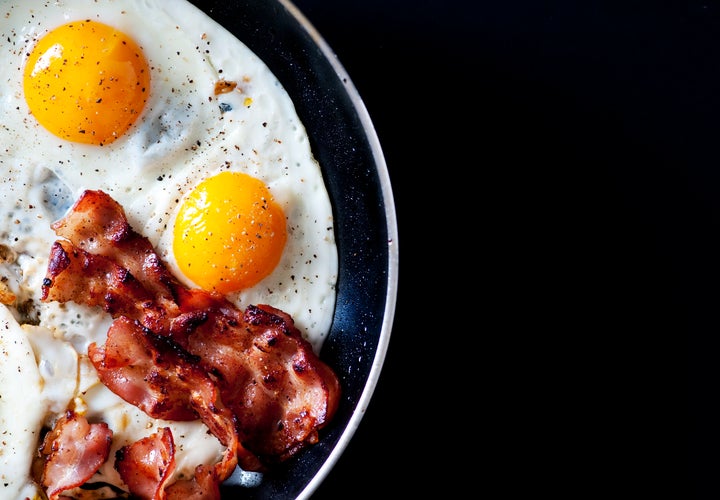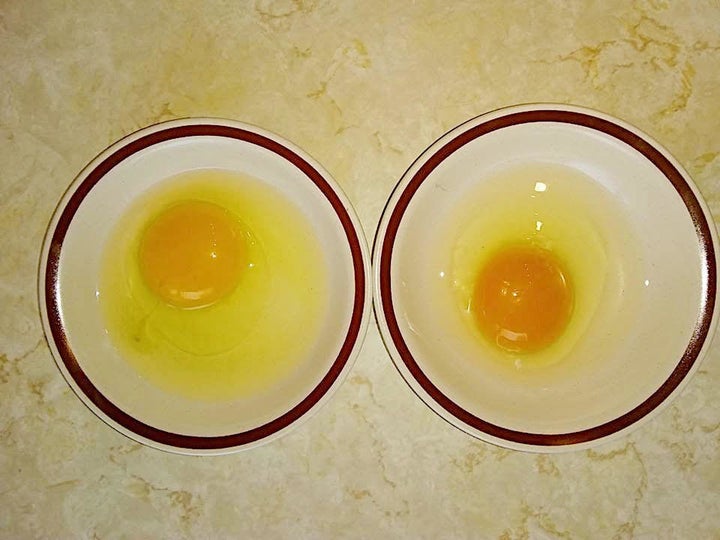
Egg yolks vary wildly in color ― from soft yellow to dark orange, even red ― and our color preference often varies depending on where we’re from. But what does the color tell us about the quality and nutrition of our eggs?
Research says it’s complicated.
Historically, a richer-colored yolk meant a healthier, more nutritious egg. Chickens that graze naturally on grass, bugs and seeds are well-nourished and produce bright orange yolks with a high percentage of nutrients and healthy fats. Factory-farmed chickens, which live in tightly packed cages and primarily feed on grain, tend to have lighter yellow yolks whose nutritional content (literally) pales in comparison to their darker orange counterparts.
We’ve known for quite some time that the color of a yolk is determined by a hen’s diet, due to a group of nutrients called carotenoids, which also give butternut squash and carrots their deep yellow hues. The higher percentage of carotenoids in a hen’s diet, the richer the color of her yolk ― meaning farmers can easily control the color based on what they feed and how they raise their birds.
“We’ve found that the more we move [the birds] and the more access they have to pasture, the brighter the yolks,” said Joel Slezak, a farmer in Free Union, Virginia, who raises 700 laying hens through a process called rotational grazing. He and partner Erica Hellen move their birds to new sections of pasture three times a week, which gives chickens constant access to fresh, rich ground to forage.
“Our customers tell us all the time that if we’re not moving them around enough or there’s not enough nutrition in the pasture, it makes a big difference in the yolk,” he said.
Dan Barber, chef and farmer at Blue Hill at Stone Barns, revealed in Season 1 of Netflix’s “Chef’s Table” that he feeds his chickens carotenoid-rich red peppers to achieve a bright, nearly blood-red yolk. But he does it less for the color than to prove a point: He’s an advocate for pasture-raised eggs and animals, and he wants to get people to pay attention “to not only what we’re eating, but what we’re eating is eating.”
A yolk can tune us into the health ― and even the living conditions ― of the chicken it came from.
A darker orange yolk tells us one of two things: that a chicken is eating a diet on open pasture, where they feed on carotenoid-rich grasses and flowers, or that they’re getting additives in their feed.
“We’ve learned that dark leafy greens and any orange/red fruits and veggies help give the yolk a very dark orange color,” said Amanda Nolan, co-owner and farmer of Dusty Hound Farms in Tetonia, Idaho. She cares for 50 laying hens on pasture that feed on bugs, grass and seeds in addition to ground-up fruit and vegetable scraps for added protein and nutrition.
“When we first started raising our chickens, their diet was mostly store-bought food and grain and occasional scraps from our house, but we weren’t seeing the rich dark yellow yolks that we wanted,” she said, adding that it took about a week to see yolks transform from pale yellow to rich orange after moving the chickens off of store-bought feed.

Carotenoid-rich fruits and vegetables add nutrition to the yolk as well. Carotenoids have strong antioxidant properties and have been shown to prevent age-related blindness. And the color of the yolk shows us that these nutrients are making it into the egg.
“The egg is the dietary reference for a chicken, meaning that the egg is there to support life for a chick,” said Casey Owens Hanning, a professor in the poultry science department at the University of Arkansas. “It’s required to have everything it needs for that chick to survive and grow.”
The healthier the chicken, the healthier the egg.
Caged chickens that don’t have access to the outdoors are given additives to alter the color of their yolks. Some of these additives (like algae, marigold flowers and orange peels) add some nutritional value, but the benefits don’t compare to a pasture-raised diet, which also gives chickens nutrients from the bugs, worms and seeds they eat in between grazing on grass ― specifically heart-healthy omega-3 fatty acids.
“If you enhance a hen’s diet with fat-soluble vitamins, they are readily reflected in the vitamin concentrations in the egg yolk, e.g. vitamin D, vitamin A and Vitamin E,” said Paul Patterson, professor of poultry science at Penn State University. “Similarly, the hen yolk reflects the fatty acid profile of her diet. If a hen gets more omega-3 fatty acids [in her diet], the yolk reflects that.”
One study found that pastured eggs have two times the vitamin E and omega-3 fatty acids of factory-farmed eggs and 38 percent more vitamin A.
So can we determine the nutrition content or quality of an egg just by looking at it?
Not exactly, but it certainly gives us a clue.
Ninety-seven percent of the eggs in the U.S. come from factory farms, so it’s safe to assume that cheap eggs with rich-colored yolks have been synthetically dyed.
This means we need to look for other cues of quality when buying eggs.
“The structure of a pastured yolk is very firm,” Slezak said. “If you crack it into your hand and let the white separate between your fingers, you can tell how much stronger it is. The whites won’t be as runny and the yolk won’t fall apart as easily.”
Labels can be misleading, too. “Organic” and “cage-free” mean very little these days. Even “free-range” means chickens are given only a small amount of fenced-in outdoor space, and it is often just cement. You can look for Certified Humane “Pasture-Raised” on labels, which guarantees at least some outdoor space.
But the highest-quality eggs probably come from your local farmers.
“We’re averaging 45 square feet per bird,” Slezak said of his hundreds of laying hens, which is a stark difference from the 2 square feet per bird required for even the most regulated “pasture-raised” eggs.
One final thing to keep in mind: Yolk color can vary throughout the year ― eggs, like everything, are a seasonal product, and even the healthiest birds lay less eggs and produce lighter-colored yolks in the winter.